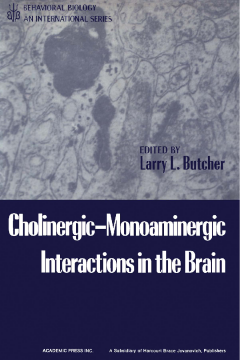
Additional Information
Book Details
Abstract
Cholinergic-Monoaminergic Interactions in the Brain investigates dynamic synaptic mechanisms in the brain and their links to various behaviors and related functional processes. More specifically, it explores neurochemical interactions by focusing on the relationship between cholinergic and monoaminergic mechanisms in the central nervous system. It also presents morphologic data to highlight the importance of structure in understanding function, particularly, that of the neostriatum and the role of acetylcholine and neurochemicals.
Organized into six sections comprised of 18 chapters, this volume begins with an overview of various models of cholinergic-monoaminergic and other chemical interactions, based in part on interactive processes that are believed to operate in the peripheral nervous system. The next chapters focus on experimental observations on electrophysiologic and neurochemical interactions in the brain and the functional correlates of such interactions. The discussion then turns to the neurohistochemical and neurobiochemical aspects of cholinergic-monoaminergic interactions, the effects on neostriatal acetylcholine levels, and the synthesis of the cortico-neostriatal and thalamo-neostriatal pathways. The reader is also introduced to the effects of lesion in the globus pallidus, the electrophysiology of interactions, the effects of drugs thought to preferentially affect monoaminergic or related neurotransmission mechanisms on acetylcholine in the brain, and whether dopamine is excitatory or inhibitory upon neostriatal neurons. Finally, the book assesses the significance of central cholinergic-monoaminergic interactions for functional processes, both normal and pathologic.
This book is a valuable resource for neuroscientists, pharmacologists, histochemists, behavioral biologists, psychobiologists, and psychologists.
